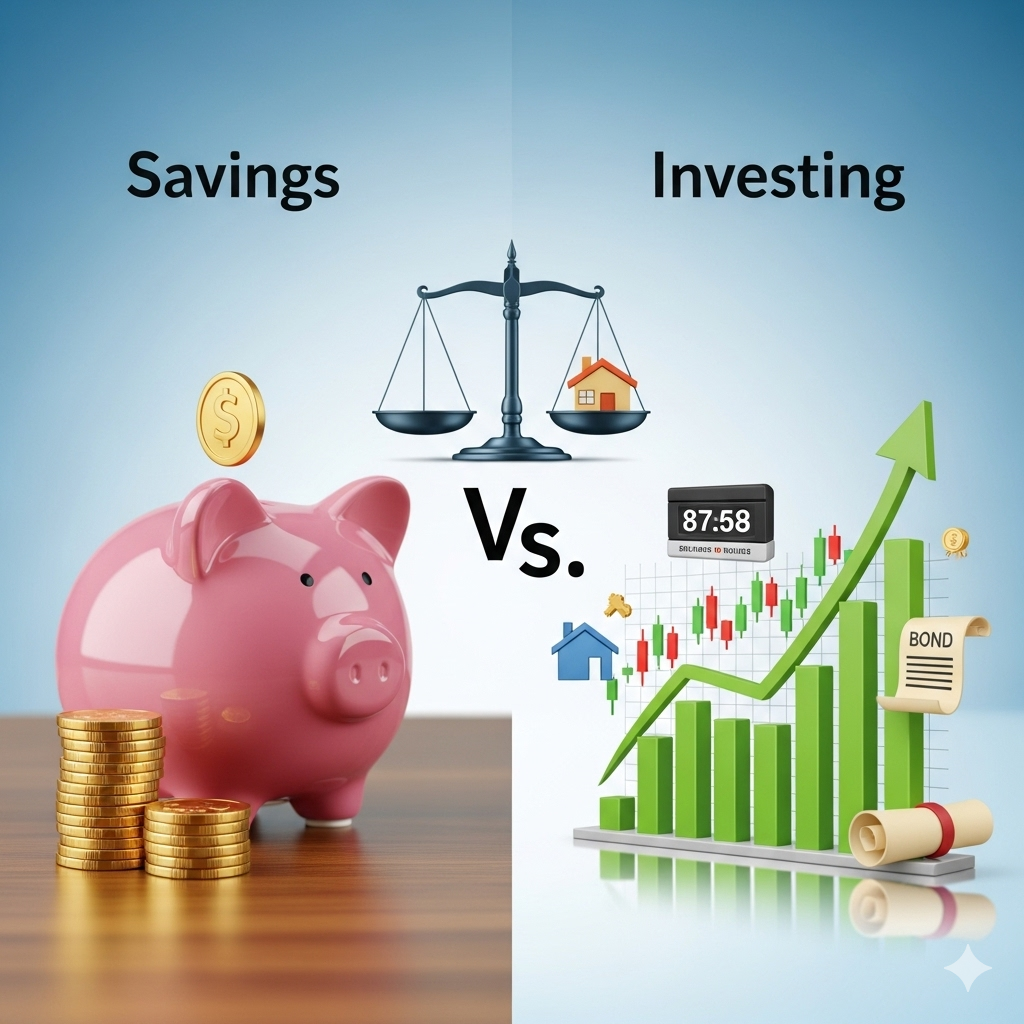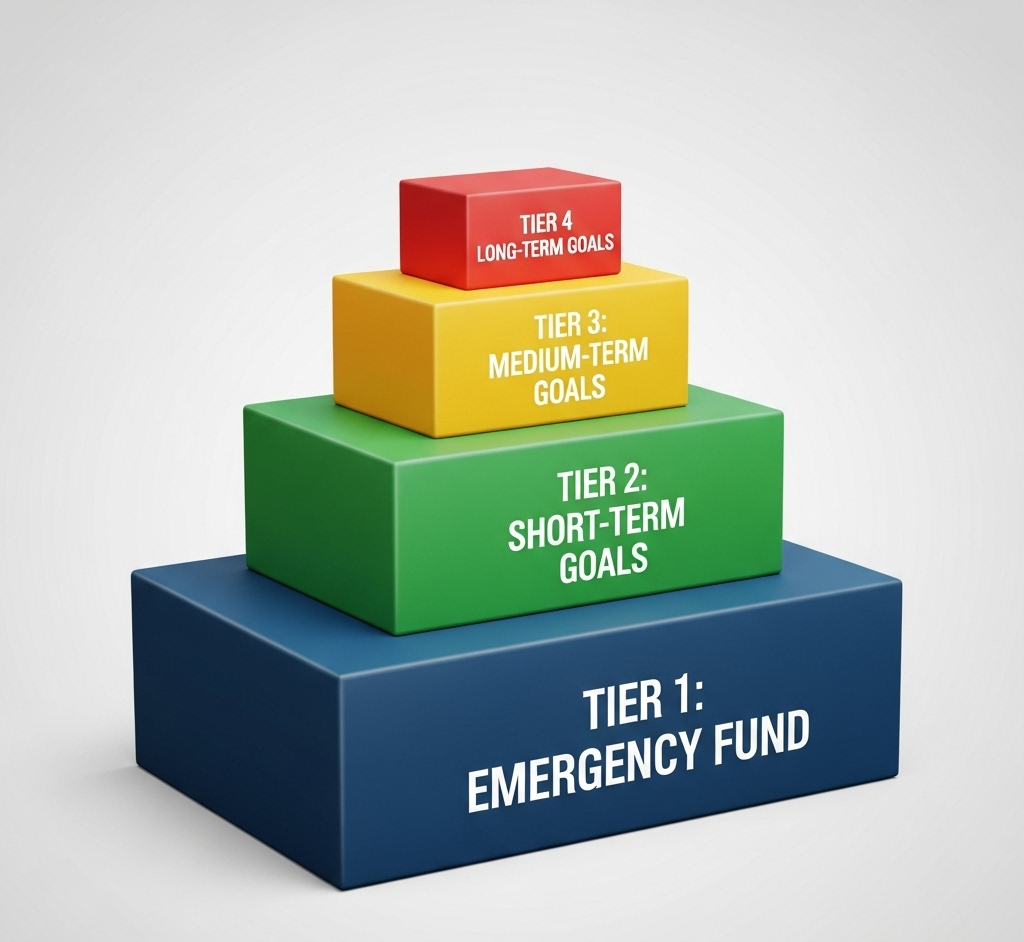Written by: Segun Akomolafe
In the journey toward financial security, you’ll inevitably face the savings versus investing dilemma. Both strategies serve distinct purposes in your financial toolkit, but understanding when to use each can dramatically impact your long-term financial health. In this article, we’ll analyze the critical topic of “Savings Vs. investing: which one should you choose?” and after reading this article, you’ll be able to make an informed decision.

Understanding the Fundamental Differences
At its core, saving means setting money aside in secure, liquid accounts like savings accounts or certificates of deposit (CDs). When you save, your primary goal is preservation of capital with minimal risk. Your money remains easily accessible, though it typically earns modest returns that may barely keep pace with inflation.
Investing, however, involves committing funds to assets that have potential to appreciate over time—stocks, bonds, real estate, or business ventures. The fundamental tradeoff is accepting higher short-term risk for potentially superior long-term returns.
When Savings Makes the Most Sense
Your emergency fund should be your financial foundation. Aim to accumulate three to six months of essential expenses in high-yield savings accounts. This isn’t about growing wealth; it’s about creating a financial buffer against life’s inevitable surprises.
For short-term goals happening within the next 1-3 years—whether buying a car, planning a wedding, or making a down payment—savings remain the prudent choice. The timeline is too short to determine whether market volatility, and certainty of capital preservation outweighs potential investment gains.
Consider Jacob, who saved $30,000 for a home down payment in a high-yield savings account earning 3.5%. While his investment-minded friends suggested putting the money in the market, Jacob’s timeline was only 18 months. When the market dropped 15% six months before his home purchase, Jacob’s savings remained intact while his friends had to postpone their plans.
When Investing Takes Priority
Once you’ve established your emergency fund and accounted for near-term financial needs, investing becomes your primary wealth-building tool. The longer your time horizon, the more you benefit from investing’s greatest advantage: compound growth.
Retirement planning exemplifies the power of long-term investing. A 30-year-old who invests $500 monthly with a 7% average annual return would accumulate approximately $591,000 by age 65. If that same person merely saved in an account yielding 1% interest, they’d have only about $245,000—less than half the amount.
Investing also provides the best defense against inflation. While inflation erodes purchasing power at roughly 2-3% annually in normal economic conditions, properly diversified investments historically outpace this rate over extended periods.
Finding Your Balance: The Four-Tier Approach

Now, savings vs. investing: which one should you choose? Here’s the catch, rather than viewing savings and investing as competing strategies, consider a tiered approach:
- Tier 1 – Emergency Fund: Maintain 3-6 months of expenses in high-yield savings accounts.
- Tier 2 – Short-Term Goals: Use CDs, money market accounts, or high-yield savings for 1-3 year goals.
- Tier 3 – Medium-Term Goals: For 3-10 year goals, consider a conservative mix of investments with some lower-risk bond components.
- Tier 4 – Long-Term Goals: For goals beyond 10 years, focus primarily on growth-oriented investments.
Each tier corresponds to a specific time horizon and risk tolerance. As your financial situation evolves, you’ll likely have money in multiple tiers simultaneously.
Psychological Factors to Consider
Your financial decisions aren’t made in an emotional vacuum. Savings provides psychological security—knowing you have accessible funds during emergencies reduces anxiety and prevents panic-selling investments at market lows.
Investing requires emotional discipline. Market volatility can trigger fear responses that lead to counterproductive behaviors. Research from Dalbar’s Quantitative Analysis of Investor Behavior consistently shows that average investors significantly underperform market indexes primarily due to emotional decision-making.
Michelle’s point of view on “savings vs. investing: which one should you choose?” was determined when she panic-sold her investments during the 2020 market crash, only to miss the rapid recovery that followed. “I was acting from fear rather than strategy,” she reflects. “That mistake taught me to align my investment approach with my emotional tolerance for volatility.”
The Impact of Life Stage on Your Strategy
Your age and life circumstances significantly influence the optimal balance between saving and investing.
In your 20s and early 30s, you benefit from time’s compounding magic—allowing you to take more investment risk while still recovering from potential market downturns. However, this is also when you’re establishing financial independence, making emergency savings particularly crucial.
As you approach middle age, your earning power typically increases, but so do your financial responsibilities. This often requires simultaneous focus on multiple goals: retirement investing, education savings, and perhaps saving for a larger home.
In pre-retirement years (your 50s and early 60s), gradually shifting some assets from growth-oriented investments toward more conservative options protects against sequence-of-returns risk—the danger that a market downturn early in retirement could permanently damage your financial security.
Common Mistakes to Avoid
Many people sabotage their financial progress by:
- Keeping excessive cash reserves beyond emergency needs, surrendering potential returns
- Investing before establishing adequate emergency savings, forcing liquidation of investments during market downturns
- Taking inappropriate risks with money needed in the short term
- Being too conservative with long-term investment allocations
- Failing to reassess the savings-investment balance as circumstances change
Considering Thomas’ point of view on “Savings Vs. investing: which one should you choose?”He kept $100,000 in a checking account earning 0.01% interest for over a decade. “I always planned to invest it ‘when the time was right,'” he explains. That opportunity cost—compared to even a conservative investment exceeded $50,000 in potential growth.
Tax Considerations That Shape Your Decision
Tax implications should inform your saving and investing strategy. Many retirement investment vehicles offer significant tax advantages:
- Tax-deferred accounts like traditional 401(k)s and IRAs allow your investments to grow without annual tax obligations until withdrawal.
- Tax-exempt accounts like Roth IRAs and Roth 401(k)s provide tax-free growth and tax-free qualified withdrawals.
Meanwhile, interest earned from savings accounts is generally taxed at your ordinary income rate, creating a tax drag on already modest returns.
For college savings, 529 plans combine elements of both approaches—functioning like investment accounts with tax-free growth for qualified education expenses.
Read more: Best Bank Bonuses and Promotions in the United States
Technology Tools That Simplify Your Strategy
Today’s financial technology makes implementing a balanced approach easier than ever. Automated savings apps can analyze your spending patterns and quietly transfer sustainable amounts to your emergency fund until it reaches your target.
Robo-advisors offer low-cost, automatically rebalanced investment portfolios aligned with your goals and risk tolerance. Many platforms now offer “goals-based” approaches that simultaneously manage multiple financial objectives with appropriate strategies for each.

Taking Action: Your Next Steps
Starting today, you can improve your financial approach:
First, calculate your essential monthly expenses and multiply by the number of months you want in your emergency fund (typically 3-6). Compare this target against your current liquid savings to identify any emergency fund gap.
Next, list your financial goals with specific amounts and timelines. Categorize each goal as short-term (under 3 years), medium-term (3-10 years), or long-term (10+ years).
For short-term goals, research high-yield savings accounts, money market accounts, or CDs to optimize your safe returns. For medium and long-term goals, consider consulting with a financial advisor about appropriate investment strategies based on your risk tolerance and time horizon.
Finally, establish automatic transfers to both savings and investment accounts. Automation removes the psychological barriers to consistent financial behavior.
Read more: 15 Best Online Banks For Reliable Savings
The Power of Integration
When you imagine savings vs. investing: which one should you choose? The question isn’t an either/or proposition—it’s about creating an integrated strategy where each component serves its proper function. Your emergency fund provides stability that allows your investments to grow undisturbed through market cycles. Your short-term savings ensure you can meet immediate goals without disrupting long-term investment strategies.
By understanding how these elements work together, you create not just financial security, but the potential for genuine wealth building over time. The most successful approach doesn’t force you to choose—it helps you leverage both savings and investing for what each does best.
Remember that your financial journey will evolve. What works in your 20s will need adjustment in your 40s and reimagining in your 60s. The constant reassessment of your savings-investment balance is itself a vital part of financial wisdom. Your future financial self will thank you for striking the right balance today!
Related Contents:
